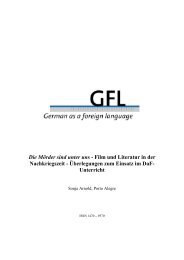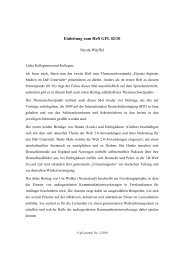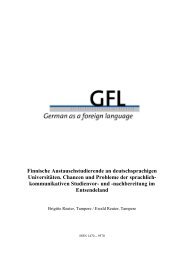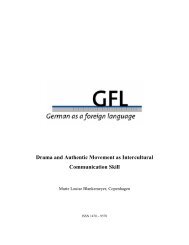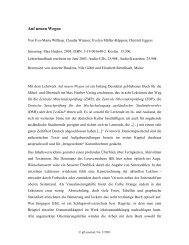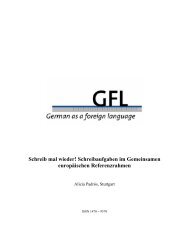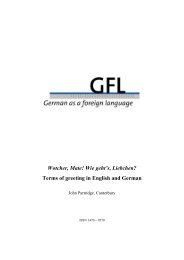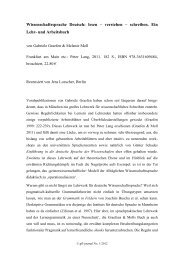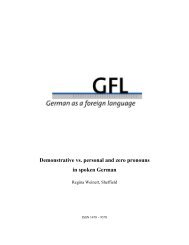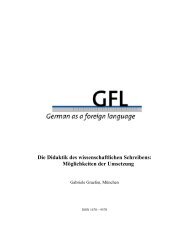Der Schulerwerb von Deutsch als Fremdsprache - GFL-Journal
Der Schulerwerb von Deutsch als Fremdsprache - GFL-Journal
Der Schulerwerb von Deutsch als Fremdsprache - GFL-Journal
You also want an ePaper? Increase the reach of your titles
YUMPU automatically turns print PDFs into web optimized ePapers that Google loves.
<strong>Der</strong> <strong>Schulerwerb</strong> <strong>von</strong> <strong>Deutsch</strong> <strong>als</strong> <strong>Fremdsprache</strong><br />
133<br />
students are mainly acquiring the passive voice and the different functions of the verb<br />
"werden". The author <strong>als</strong>o investigates general developmental tendencies concerning the<br />
nominal and pronominal declension system, syntactic complexity, and the use of parts of<br />
speech (verbs, nouns, pronouns, adjectives, adverbs, particles, conjunctions, and<br />
prepositions). In her pragmatic analysis, she investigates the range of linguistic actions used<br />
by the students, their use of procedures as defined by Ehlich (see Ehlich 1991) and their use<br />
of the modal field. She <strong>als</strong>o assesses the coherence of their productions, topic development,<br />
degree of explicitness and recipient guidance as well as aspects of their oral production (e.g.<br />
eye contact or gestures).<br />
Chapter 4 summarizes the results from a different perspective. The author reviews her most<br />
important insights according to student population and thus traces a reconstructed general<br />
developmental path. A minute exemplary detail from the pragmatic domain may illustrate<br />
Terrasi-Haufe’s encompassing approach: Whereas students’ linguistic actions at the end of<br />
middle school mainly consist of assertions, reports, and cognitive reasoning, their repertoire<br />
of assertive actions doubles in the first year of high school, and they begin to express attitudes<br />
(such as regret, astonishment and doubt) and to direct their hearers (with linguistic actions<br />
such as requests, advice, recommendations) (see Terrasi-Haufe 2004:180ff.).<br />
With its focus on student populations, chapter 4 provides a transition to the practical<br />
conclusions and recommendations for <strong>GFL</strong> instruction featured in chapter 5. A result<br />
particularly noteworthy to education administrators is that middle school students in Terrasi-<br />
Haufe’s corpus do not meet the go<strong>als</strong> defined in the school curricula for this level. In terms of<br />
teaching methodology, the author’s recommendations are primarily concerned with increasing<br />
explicit instruction on functional aspects of grammar and using examples of authentic<br />
communication in the classroom. The book <strong>als</strong>o contains an appendix of 79 pages showing<br />
the instruments used for data collection, transcription, and analysis.<br />
Evaluation<br />
Among the many strong points of this analysis, three aspects are to be mentioned in<br />
particular. First of all, Terrasi-Haufe has taken great care in creating a representative sample.<br />
To ensure a high-quality data base, she collected data from roughly 440 students and reduced<br />
these in two steps. In a first step, she selected only complete or virtually complete data series.<br />
This approach appears especially adequate since, for one of her three corpora, she followed<br />
students thoughout their transition from middle school to different vocational schools and<br />
© gfl-journal, No. 2/2005



